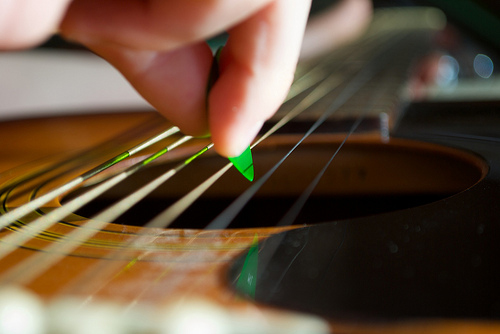Musical Fluency: Strumming Rhythm, Part 2

In my previous post, Strumming Rhythm, Part 1, we checked out all different possible binary rhythms using eighth notes and 16th notes.
Let’s see what happens now when ties get thrown into the mix.
The Tie
A tie is a curved line connecting two notes of the same pitch. What this does is extend the first note for the length of the second note. In other words, it adds the two tied notes together. For example, if an eighth note is tied to another eighth note, you end up with the length of a quarter note.
Typically, ties happen across beats or across measures. You don’t really need to tie together two 16th notes in the same beat, because you can just rewrite them as one eighth note.
Playing a tie when you’re strumming isn’t too hard in theory. All you have to do is swing your arm as if you’re going to play the tied note, but don’t hit the strings. Miss on purpose.
Let’s check out a few examples.
Strumming With Ties
Here’s a really popular strumming example, using an Em chord:

All I did here was take two of the rhythmic examples from Part 1 and then tie them together. Notice the D’s and U’s indicating down and up strumming directions. The D in parentheses indicates you swing your arm down but don’t hit the strings.
Here’s a slightly trickier example using more syncopation, meaning more up-strums.

Notice that the tie is treated the same way. Just miss the strings on purpose for the tied note.
Strumming With Ties and Dotted Rhythms
Dotted rhythms add an extra challenge, since they already involve a “missed” strum if you’re strumming down with the eighth note. Here’s one example using a dotted eighth and 16th note rhythm.

Notice how there are two missed down strums for that dotted rhythm. It’s really important to keep swinging your strumming arm with that eighth-note pulse. That way you’ve basically got a metronome built into your body, allowing you to play around with the rhythm while keeping the beat.
Check out this last example using another dotted eighth note rhythm.

This example has an extra “missed” down strum at the end, right where the last eighth note pulse falls.
Practice
For practice, try pairing together different rhythm from Part 1 and tying them together. There are seven different rhythms to choose from, so there are a lot of possible pairings.
Start of with just a couple different pairs and work with them along with a metronome until that missed down strum feels comfortable.
The more different rhythms you practice, the more versatile you’ll be as a rhythm guitarist. Eventually you won’t have to worry about up and down patterns any more. You’ll be able to strum whatever rhythm you like, because you’ll have worked all the different possibilities into your strumming arm.
Ben Rainey works as a guitar teacher and freelance guitarist in the Pittsburgh area. He's also in charge of music content at Tunessence.com.
Get The Pick Newsletter
All the latest guitar news, interviews, lessons, reviews, deals and more, direct to your inbox!









